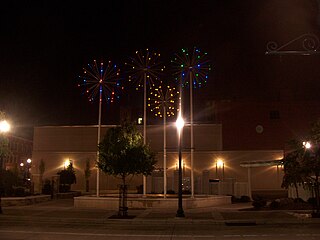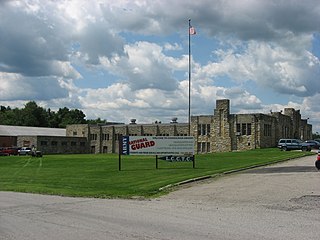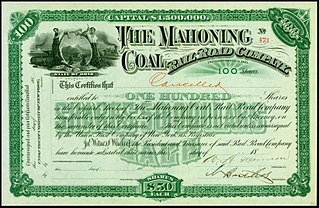
New Castle is the county seat of Lawrence County, Pennsylvania, United States. It is 50 miles (80 km) northwest of Pittsburgh, and near the Pennsylvania–Ohio border, just 18 miles (29 km) southeast of Youngstown, Ohio. As of the 2020 U.S. Census, the city had a population of 21,926. It is the commercial center of a fertile agricultural region, officially the New Castle, PA Micropolitan Statistical Area, which had a population of 86,070 in 2020. New Castle also anchors the northwestern part of the Pittsburgh-New Castle-Weirton, PA-WV-OH Combined Statistical Area.

Shenango Township is a township in Lawrence County, Pennsylvania, United States. The population was 7,479 at the 2010 census. Shenango Township is situated between the city of New Castle to the north and the borough of Ellwood City to the south.
U.S. Route 224 (US 224) is a spur of US 24 that runs through the states of Indiana, Ohio and Pennsylvania. It currently runs for 289 miles (465 km) from Huntington, Indiana, at US 24 to New Castle, Pennsylvania, at US 422 Business and Pennsylvania Route 18 (PA 18). It goes through the cities of Canfield, Ohio, Akron, Ohio, and Findlay, Ohio. In Northeast Ohio, US 224 is located a short distance north of the Western Reserve's southern boundary.

The Pittsburgh and Lake Erie Railroad (P&LE), also known as the "Little Giant", was formed on May 11, 1875. Company headquarters were located in Pittsburgh, Pennsylvania. The line connected Pittsburgh in the east with Youngstown, Ohio at nearby Haselton, Ohio in the west and Connellsville, Pennsylvania to the east. It did not reach Lake Erie until the formation of Conrail in 1976. The P&LE was known as the "Little Giant" since the tonnage that it moved was out of proportion to its route mileage. While it operated around one tenth of one percent of the nation's railroad miles, it hauled around one percent of its tonnage. This was largely because the P&LE served the steel mills of the greater Pittsburgh area, which consumed and shipped vast amounts of materials. It was a specialized railroad deriving much of its revenue from coal, coke, iron ore, limestone, and steel. The eventual closure of the steel mills led to the end of the P&LE as an independent line in 1992.

The Mahoning River is a river located in northeastern Ohio and a small portion of western Pennsylvania. Flowing primarily through several Ohio counties, it crosses the state line into Pennsylvania before joining with the Shenango River to form the Beaver River. The Mahoning River drops from 1,296 feet (395 m) at the headwaters near Winona to 761 feet (232 m) at the outfall near Mahoningtown, Pennsylvania. It is part of the Ohio River watershed.

The J.G. Brill Company manufactured streetcars, interurban coaches, motor buses, trolleybuses and railroad cars in the United States for almost ninety years, making it the longest-lasting trolley and interurban manufacturer. At its height, Brill was the largest manufacturer of streetcars and interurban cars in the US and produced more streetcars, interurbans and gas-electric cars than any other manufacturer, building more than 45,000 streetcars alone.

Pittsburgh, surrounded by rivers and hills, has a unique transportation infrastructure that includes roads, tunnels, bridges, railroads, inclines, bike paths, and stairways.

The Shenango River is a principal tributary of the Beaver River, approximately 100 mi (160 km) long, in western Pennsylvania in the United States. It also briefly flows through small portions of northeastern Ohio. Via the Beaver and Ohio Rivers, it is part of the watershed of the Mississippi River.

Streetcars and interurbans operated in the Maryland suburbs of Washington, D.C., between 1890 and 1962. Lines in Maryland were established as separate legal entities, but eventually they were all owned or leased by DC Transit. Unlike the Virginia lines, the Washington and Maryland lines were scheduled as a single system. Most of the streetcar lines were built with grand plans in mind, but none succeeded financially. A combination of the rise of the automobile, various economic downturns and bustitution eventually spelled the end of streetcars in southern Maryland.
Pennsylvania Route 108 is a highway in Western Pennsylvania that runs for 32 miles (51 km) from the Ohio state line near SNPJ to PA 8 in Adams Corner. PA 108 intersects Interstate 376 (I-376) near New Castle and U.S. Route 19 (US 19) near Harlansburg. PA 108 also has an interchange with Interstate 79 (I-79) at exit 105.
The Hagerstown & Frederick Railway, now defunct, was an American railroad of central Maryland built in the 19th and 20th centuries.

State Route 289 (SR 289) is a 9.93-mile (15.98 km) east–west state highway in the northeastern quadrant of the U.S. state of Ohio. The western terminus of SR 289 is at a diamond interchange with U.S. Route 422 (US 422) and SR 193 in Youngstown. Its eastern terminus is at the Pennsylvania state line just 0.50 miles (0.80 km) east of Lowellville. Continuing east into Pennsylvania after SR 289 ends is locally-maintained Graham Road.

The Lehigh Valley Transit Company (LVT) was a regional transport company, headquartered in Allentown, Pennsylvania, that began operations in 1901 as an urban trolley and interurban rail transport company. It operated successfully into the 1930s, struggled financially during the Great Depression, and was saved from abandonment by a dramatic ridership increase due to the Second World War. In 1951, the LVT, once again financially struggling, ended its 36-mile (58 km) interurban rail service from Allentown to Philadelphia. In 1952, it ended its Allentown area local trolley service. It operated local bus service in the Allentown, Bethlehem, and Easton, Pennsylvania, areas until going out of business in 1972.
The Youngstown and Southeastern Railroad is a short-line railroad subsidiary of Midwest & Bluegrass Rail that operates freight trains between Youngstown, Ohio and Darlington, Pennsylvania, United States. The line is owned by the Columbiana County Port Authority, leased to the Eastern States Railroad, which is owned by the line's primary shipper, and contracted out to the YSRR. Freight is interchanged with CSX Transportation and the Norfolk Southern Railway at the Youngstown end.

Lawrence County is a county located in the U.S. state of Pennsylvania. As of the 2010 census, the population was 91,108. The county seat is New Castle.
Atlanta's transportation system is a complex infrastructure of several systems, including 47.6 miles of heavy rail, 91 bus transit routes, 1,600 licensed taxis, a comprehensive network of freeways, the world's busiest airport and over 45 miles of bike paths.
Frizzleburg is an unincorporated community and census-designated place (CDP) in Lawrence County, Pennsylvania, United States. The population was 602 at the 2010 census.

The Mahoning Coal Railroad (MCR) was a railroad line in the U.S. states of Ohio and Pennsylvania. Incorporated in 1871, it largely linked Youngstown, Ohio, with Andover, Ohio. It had a major branch into Sharon, Pennsylvania, and several small branches and spurs to coal mines and iron works along the Ohio-Pennsylvania border. The railroad leased itself to the Lake Shore and Michigan Southern Railway in 1873. The lease was assumed by the New York Central Railroad in 1914, when that company consolidated with the Lake Shore & Michigan Southern. The New York Central merged with the Pennsylvania Railroad in 1968 to create the Penn Central. Despite abandonment of much track, bankruptcy of the Penn Central in 1970 eventually caused the MCR's dissolution on January 7, 1982.

The Cleveland and Mahoning Valley Railroad (C&MV) was a shortline railroad operating in the state of Ohio in the United States. Originally known as the Cleveland and Mahoning Railroad (C&M), it was chartered in 1848. Construction of the line began in 1853 and was completed in 1857. After an 1872 merger with two small railroads, the corporate name was changed to "Cleveland and Mahoning Valley Railroad". The railroad leased itself to the Atlantic and Great Western Railway in 1863. The C&MV suffered financial instability, and in 1880 its stock was sold to a company based in London in the United Kingdom. A series of leases and ownership changes left the C&MV in the hands of the Erie Railroad in 1896. The CM&V's corporate identity ended in 1942 after the Erie Railroad completed purchasing the railroad's outstanding stock from the British investors.













